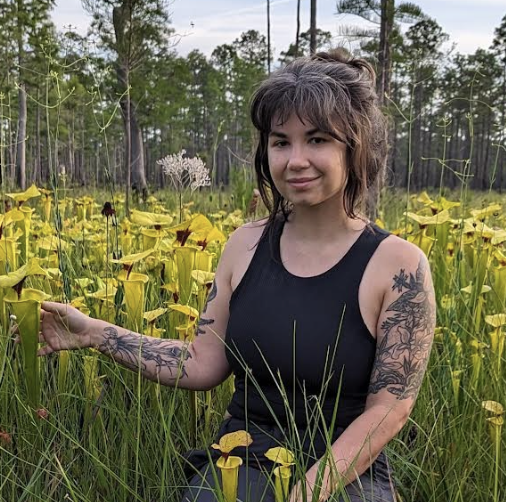October 25, 2023- by Dani Davis
Changing Plants, changing ecosystems along the Apalachicola River
Plants are windows into the landscape. They open the worlds of unseen, underlying geology and hydrology and teach us about the changing landscape. The Apalachicola River winds its way through sandhills, floodplain forests, swamps, and salt marshes, where it meets the Bay. Paddling the 107 miles from its start in Chattahoochee, day after day, spending hours looking at the plants along the riverside revealed the small-scale changes that ended in vastly different landscapes.

Bluffs and ravines: Chattahoochee – Estiffanulga
Where the kayaks enter the water in Chattahoochee, the river flows through a region full of high sandy bluffs and ravines. This region is known for its high levels of plant and animal diversity, with many endemic and endangered species. Though these endangered species weren’t visible from the river, the most striking aspect of the forest along the banks was the amount of broken, shrubby, stunted trees. Many of us remember and talked of the devastation that Hurricane Michael brought in 2018, which was still very apparent on either side of the river. Fast-growing plants like fennel and muscadine vines twisted their way through shrubby trees. Even five years after this category 5 hurricane ripped through the Apalachicola River Basin, the damage remains apparent. Despite the damage to the surrounding forest, the high sandy bluffs still bloomed with goldenrods (Solidago) and ferns hung close to the water.

Hardwood Forest and Swamp: Estiffanulga – Owl Creek

The gradual shift into hardwood forest and then into swamp became apparent as we paddled south from Bristol with the sighting of “firsts”. We would call out the first saw palmetto, or first tupelo tree, which would multiply in abundance as we continued the journey south. One of the most incredible sights on the riverbanks between Estiffanulga and Owl Creek was the abundance of fall wildflowers. Tall ironweed (Vernonia gigantea) and blue mistflower (Conoclinium coelestinum) added splashes, and occasionally huge patches, of purple and blues to the riverbanks. Goldenrod (Solidago) and white asters often joined them, adding soft golds and whites to the show of cool tones.
As we paddled the stretch of river between Wewahitchka and Owl Creek, the broad widening of the floodplain and transition from bottomland forest to swamp became apparent by the slow appearance of saw palmetto, tupelo, and an increase in abundance of cypress trees. Throughout the day, we watched the oaks and maples become less and less common, with cypress and tupelo trees taking their place. On our stops, we noticed that we sank into the mud on the bank rather than standing firm on the coarser sand that we experienced upstream. As we paddled into Owl Creek, the transition was made complete when we entered the stunning cypress and tupelo swamp, complete with spider lilies and plenty of Spanish moss.


Hardwood Swamp to Marsh: Owl Creek – Apalachicola
Starting from Owl Creek on our final day of paddling, with the wind at our backs, we witnessed the starkest change in the landscape – the loss of trees and the emergence of salt marsh. As we moved through the large floodplain, we started to notice the cabbage palms. First, just one or two, until they became a major component of the shoreline. We began to talk about wetland plants, how saltwater changes the types of plants growing in an area and were on the watch for Pickerelweed – a favorite wetland plant of some of the paddlers. Tired of seeing water hyacinth, a non-native, weedy plant that causes issues along the shoreline, we were ready to see the tall purple flowers of pickerelweed instead of the shorter lavender water hyacinth flowers. Along the way, we pointed out rivercane, a native bamboo, growing at Bloody Bluff, and the non-native, weedy Giant Cane that became more noticeable moving south. As we rounded the bends in the river past the split where the St. Marks joins the Apalachicola River, we began to see fewer trees and classic marsh grasses come into view, along with a sighting of pickerelweed. One of the paddlers shouted, “There’s seagrass below!”, looking down excitedly, we saw seagrasses sticking up out of the mud. Surrounding us were Juncus and Spartina, with an occasional cabbage palm as we looked further downstream to the bridge, where the River meets the Bay. Pulling our boats out of the water in Apalachicola, there were no longer floodplain trees, the cypress and tupelo of the early day and the maples of days before were gone, now we were in the land of salt marshes, seagulls, and seagrasses.

From sandhills to salt marsh over 5 days, watching nature change, expressed by the plants and animals that make their homes in a landscape of changing geology and hydrology. Through the river, we bore witness to this change through the plants that marked our journey, the maples and sweetgums, the tupelo and cypress, and the seagrass and marsh grasses.
 Dani Davis is Director of Outreach at Apalachicola Riverkeeper. If she’s not around, Dani can be found exploring bogs, paddling under cypress trees, or making art that highlights the unique biodiversity of our region.
Dani Davis is Director of Outreach at Apalachicola Riverkeeper. If she’s not around, Dani can be found exploring bogs, paddling under cypress trees, or making art that highlights the unique biodiversity of our region.
